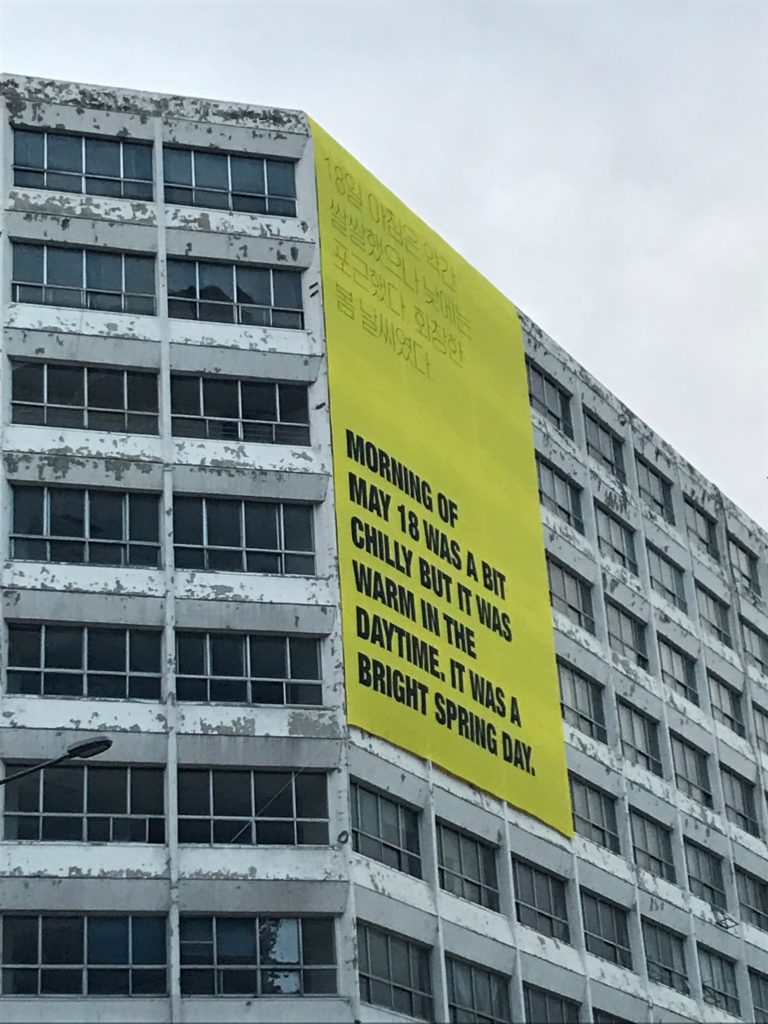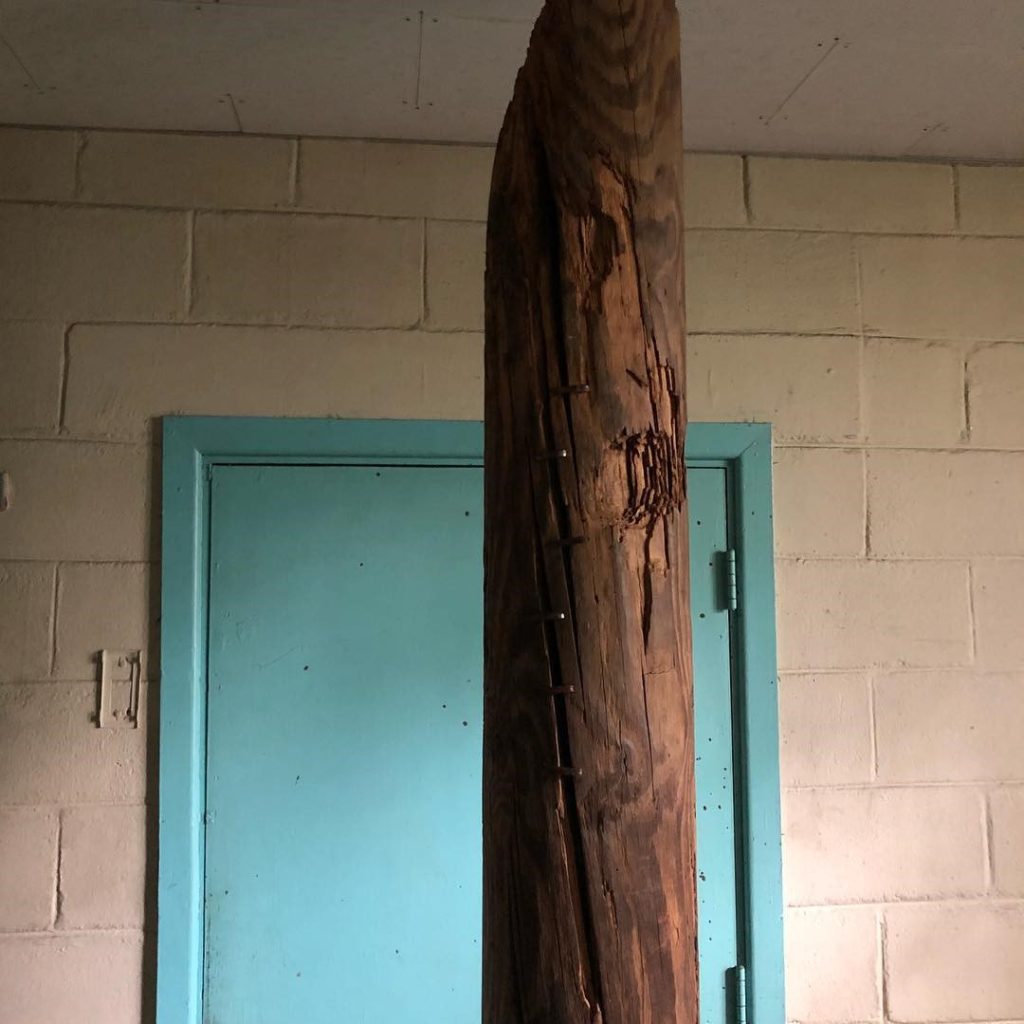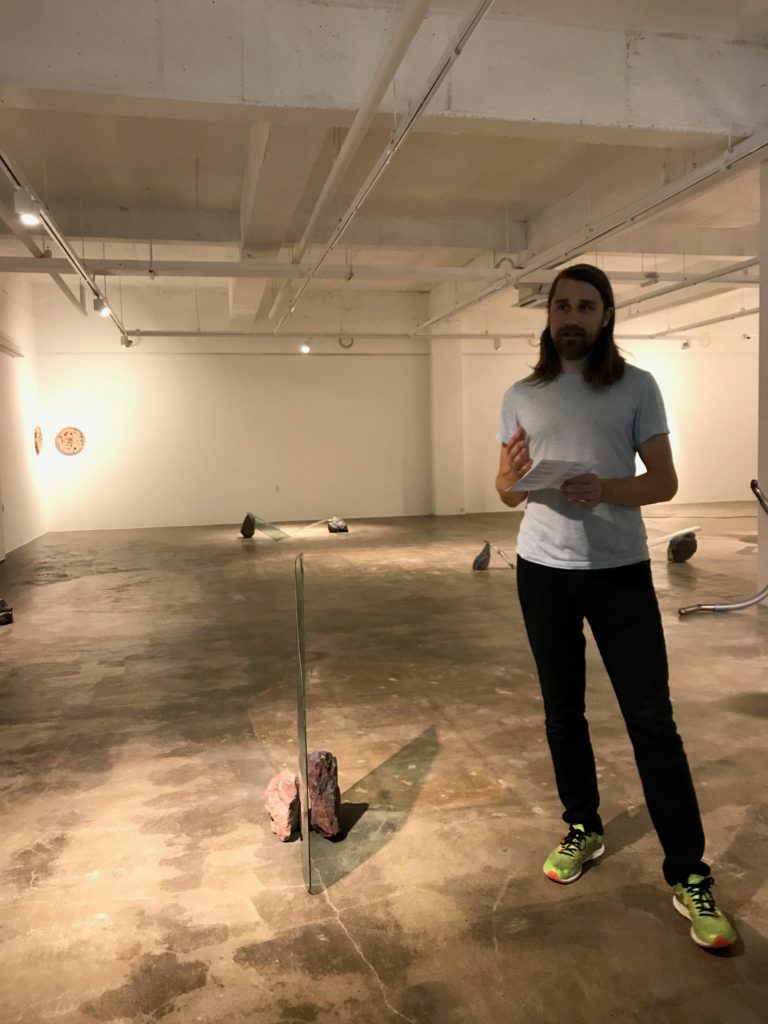The Gwangju Biennial, traumatic memory and undetermined futures
By Eleanor Stephenson
Celebrating its 12th anniversary, the Gwangju Biennial began as an arts festival to commemorate the young lives lost during the 1980 Gwangju Uprising. Freedom of oppression is a recurrent theme seen through-out the pavilions, celebrated through an array of thought provoking artworks and site-specific installations. Most of these spaces are reused, recycled and borrowed from the city, encouraging visitors to engage with local culture and cuisine. This experience, combined with the works on display, presents a raw and unfiltered picture of the hardships faced by suppressed people, not just in Korea but globally.

One of the main venues for the Biennial is the Asian Cultural Centre. This building complex previously housed the regional government offices that students gathered around in protest on the morning of May 18th, 1980. This black and white photograph was taken only hours before thousands of these students were murdered by the military in this square.

The harrowing memories surrounding the struggle for democratic freedom are felt in the city and are visible in its very infrastructure. Directly above the square is another former government building, however, it is disused and depilated, marking these unresolved traumas. Korean artists Yejou Lee, Joungmin Yi and Shiu Jin, have utilised the juxtaposition of past and present by hanging an enormous banner from the top of this multi-storey office. Rather than explicitly narrate the Gwangju Uprising, the Okin Collective have taken abstract descriptions and quotes from witnesses, creating an eerily real connection with the victims of this tragic event.

A short drive from the Asian Cultural Centre, was the GB Commission, whose venue was another reminder of the brutality of the military government. In the Former Armed Forces’ Gwangju Hospital, artists Adrián Villar Rojas, Mike Nelson, Kader Attia, and Apichatpong Weerasethakul created site specific installations. French artist, Kader Attia, placed monolithic planks of wood, in the centre of a few disused rooms. The presence of these pieces in the hospital remind the viewer of the beings that would have been there, either as casualties or as wounded captives. Walking down the dimly lit corridor, was as much of a thought-provoking installation as the site-specific sculptures.

The title for this year’s Biennial is Imagined Borders, adopted from Benedict Anderson’s book about nationalism: Imagined Communities. This theme was explored through a variety of avenues and issues, such as immigration, border conflict, colonialism, race and environmental politics. One of the most impressive explorations was by the Helsinki International Artists Program (HIAP), curated by Jenni Nurmenniemi, showing six artists, including Maelee Lee, Mire Lee, and Elina Vainio, in the Mugaksa Temple. Finnish artist Nestori Syrjälä, discussed the psychological effects of global warming experienced by environmental scientists. The quotes gathered by the artist from scientists had been carved onto re-used plastic car windows and placed on rocks found in the local area. The subtlety of the works spoke of the silent torture faced by environmental researchers whose daily routine involves bearing witness to the earth’s self-destruction.

Despite the heavy themes and issues raised by this year’s Gwangju Biennial, there was a sense of enlightenment upon departure. Since 1995, the South Korean government has set-up, funded and promoted a celebration of democracy through an annual contemporary arts festival. This represents both its progressive outlook and enables a unique opportunity for other states to discuss freedom of expression, in the past, present and future.
The 12th Gwangju Biennale took place from September 7th to November 11th 2018
La Biennale de Gwangju, mémoire traumatique et avenir indéterminé
Par Eleanor Stephenson
La Biennale de Gwangju (Corée du Sud), qui célèbre son 12ème anniversaire, a débuté en tant que festival des arts pour commémorer les jeunes disparus lors du soulèvement de Gwangju en 1980. La liberté face à l’oppression est un thème récurrent dans les pavillons. Elle est célébrée au travers de nombreuses œuvres d’art et installations in situ incitant à la réflexion. La plupart de ces espaces sont réutilisés, recyclés et empruntés à la ville, encourageant les visiteurs à s’engager dans la culture et la cuisine locales. Cette expérience, combinée aux œuvres exposées, présente un tableau brut et non filtré des difficultés auxquelles font face les personnes réprimées, non seulement en Corée, mais dans le monde entier.
Le Centre culturel asiatique est l’un des lieux principaux de la Biennale. Ce bâtiment abritait auparavant les bureaux du gouvernement régional autour desquels les étudiants s’étaient rassemblés pour protester le matin du 18 mai 1980. Cette photographie en noir et blanc a été prise quelques heures à peine avant que des milliers de ces étudiants soient assassinés par les militaires sur cette place.
Les souvenirs douloureux de la lutte pour la liberté démocratique se font sentir dans la ville et sont visibles dans son infrastructure même. Juste au-dessus de la place se trouve un autre ancien bâtiment du gouvernement qui, aujourd’hui désaffecté et en ruines, symbolise ainsi ces traumatismes non résolus. Les artistes coréens Yejou Lee, Joungmin Yi et Shiu Jin ont utilisé la juxtaposition du passé et du présent en suspendant une énorme bannière au sommet de ce bureau à plusieurs étages. Plutôt que de raconter explicitement le soulèvement de Gwangju, le collectif Okin a sélectionné des descriptions abstraites et des citations de témoins, créant ainsi un lien étrangement réel avec les victimes de cet événement tragique.
Non loin du Centre culturel asiatique, se trouve la Commission de Grande-Bretagne, lieu qui rappelle la brutalité du gouvernement militaire. Dans l’ancien hôpital des forces armées de Gwangju, les artistes Adrián Villar Rojas, Mike Nelson, Kader Attia et Apichatpong Weerasethakul ont créé des installations spécifiques pour l’espace. L’artiste français Kader Attia a placé des planches de bois monolithiques au centre de quelques salles abandonnées. La présence de ces pièces au sein de l’hôpital rappelle au spectateur les personnes qui auraient pu être là, soit en tant que victimes, soit en tant que captifs blessés. Arpenter le couloir faiblement éclairé est une expérience qui suscite autant la réflexion que les sculptures précédentes.
Cette année, la Biennale a pris le titre de « Frontières imaginées », tiré du livre de Benedict Anderson sur le nationalisme : « Communautés imaginées ». Ce thème a été exploré à travers une variété de pistes et de problématiques, tels que l’immigration, les conflits frontaliers, le colonialisme, le racisme et la politique environnementale. L’une des explorations les plus impressionnantes a été celle du Programme International d’Artistes d’Helsinki (HIAP), organisée par Jenni Nurmenniemi, qui a présenté six artistes, dont Maelee Lee, Mire Lee et Elina Vainio, dans le temple Mugaksa. L’artiste finlandais Nestori Syrjälä a évoqué les effets psychologiques du réchauffement climatique ressenti par les scientifiques de l’environnement. Les citations recueillies par l’artiste auprès de scientifiques ont été gravées sur des fenêtres de voiture en plastique réutilisées et placées sur des rochers trouvés dans les environs. La subtilité des œuvres évoque la torture silencieuse à laquelle sont confrontés les chercheurs en environnement dont le quotidien consiste à témoigner de l’autodestruction de la Terre.
Malgré les thèmes et les problèmes profonds soulevés par cette édition de la Biennale de Gwangju, un sentiment d’illumination s’éveille au moment de partir. Depuis 1995, le gouvernement sud-coréen a mis en place, financé et promu une célébration de la démocratie dans le cadre d’un festival annuel d’art contemporain. Cela représente à la fois sa perspective progressiste et une occasion unique pour d’autres pays de débattre de la liberté d’expression, passée, présente et future.
La 12ème Biennale de Gwangju s’est déroulée du 7 septembre au 11 novembre 2018
